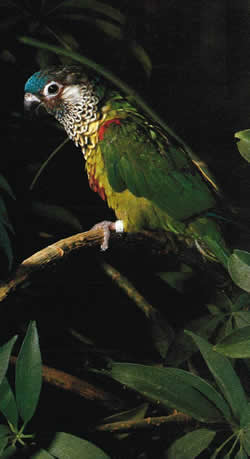Conure - White Eared
Scientific Name: Pyrrhura leucotis leucotis
Thu, 3rd July, 2025 - 7:24 am GMT
Sponsor Ads:

Alternative Name
Scientific Name: Pyrrhura leucotis leucotisBasic Info
White-eared Conures have white marks where their ears are located, as you guessed from the name. Their foreheads, lower cheeks and occasionally their napes are blue. The upper cheeks, napes and crown are all a mahogany red color. A band of mahogany red is located above the cere, and the rest of the bird is green in coloration. The chest is generally barred green and has yellow-orange edging with dark gray or black tips. White-eared Conures have maroon abdomens and lower backs. The tails are also maroon, edged with green. The shoulders of White-eared Conures have scarlet splashes, and often the wing coverts are aqua colored with blue primary flight feathers! The feet and legs tend to be a shade of gray, and the beak and eye rings are a brownish gray color. The base of the bill is narrowly striped with dark brown. White-eared Conures are quite small, and most do not grow to be more than eight and a half inches or more than two and a half ounces. They are charming and beautifully colored.
Health
These birds need fresh air and sunlight, but should be sheltered from cold, wind and rain. White-eared Conures need fresh water at all times. For food, they may be offered a basic seed mix along with fresh food. Provide a variety of fresh foods to prevent your birds from getting bored. White-eared Conures like beans, wheat bread, hibiscus leaves, flowers, and a variety of fruits and vegetables White-eared Conures do very well in cages that are two feet by two feet by four feet in dimension. Be sure the cage is extremely sturdy, as Conures are experts at chewing through almost anything. For a nesting box, 17 inches by one foot by eight and a half inches is fine. Most birds enjoy a box with a three-inch outer room, so they can sleep in one "room" and have an observation deck as well. Breeding It may be difficult to breed White-eared Conures, as they have not been consistently bred in the United States. Breeding success seems to be good, however, in Europe. White-eared Conures prefer to breed in extreme privacy in their nesting boxes. Mating overtures include offering food to the mate, rough-and-tumble play, and fussy nest-box or feather arranging. Usually, White-eared Conures lay four to eight eggs, which incubate for approximately 22 days. White-eared Conure females do all of the egg sitting, and generally will stay in the nest until the chicks are about three weeks old. At around five weeks of age, the chicks will leave the nest and by seven weeks, the parents stop feeding them. The chicks should be hand fostered.Habitat
N/ABehavior
Relatively scarce among American Conure keepers, the White-eared Conure is quite well known in Europe. These friendly, lovely little birds are worth getting familiar with wherever you may live. White-eared Conures are native to the jungles of Brazil, where they live in groups or pairs. They enjoy flying in the forest canopy and subsist on fruits, berries, seeds, nuts and the occasional insect or larva. In captivity, White-eared Conures are just as noisy as they are in the wild. They are intelligent and quite independent, and need lots of toys or chew-items to keep them entertained. White-eared Conures are social animals, and will do well when kept in pairs. They are playful and wildly entertaining. Like all Conures, it is best to keep White-eared Conures in very sturdy cages elevated about five feet from the ground. These birds need fresh air and sunlight, but should be sheltered from cold, wind and rain. White-eared Conures need fresh water at all times.They need a nest box to sleep and hide in, but also need playtime and affection in proportion with security and privacy.Origin
BrazilHistory
There are actually about nine subspecies of White-eared Conure. They were recognized in 1820 by Kuhl and are known in German as Weissohrsittich. Although quite common in Europe where they first arrived in 1871, White-eared Conures are less popular in the United States. They are native to the tropic and subtropic wet forests of eastern Brazil and to a lesser extent Venezuela.Common Foods
For food, they may be offered a basic seed mix along with fresh food. Provide a variety of fresh foods to prevent your birds from getting bored. White-eared Conures like beans, wheat bread, hibiscus leaves, flowers, and a variety of fruits and vegetablesSponsor Ads:
"If those who are sent to draw water begin by drinking themselves, the army is suffering from thirst." -- Sun Tzu, The Art of War
Conure - White Eared
Coded by: BGID® | ALL RIGHTS RESERVED Copyright © 2000-2025
Disclaimer | Privacy | Report Errors / Contact | Credits








 Preparing For China. China is growing their military. China Military Technology - can it keep up with the US?
Preparing For China. China is growing their military. China Military Technology - can it keep up with the US?  versus
versus 

 versus
versus 
 This Thread is about the North Korean Military itself - the kind of army, navy, and air force they have.
This Thread is about the North Korean Military itself - the kind of army, navy, and air force they have. 
 versus
versus 
 versus
versus  versus
versus